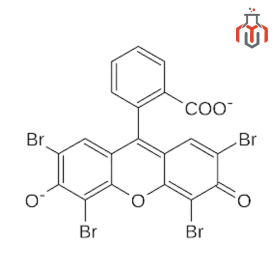

Eosin Y, also called Acid Red 87, is a xanthene dye used for differential connective tissue and cytoplasm staining. It is a member of the triarylmethane dye family, synthesized from fluorescein by bromination. It is used in Romanowsky stain and Papanicolaou’s EA solution for staining exfoliative cytology in cervical cancer screening. It was discovered by Heinrich Caro in 1874, but was first used as a histological stain by Ernst Fischer in 1876. Earlier, it was used in the textile industry and as a paint under the name ‘geranium lake.’ Besides biological staining, Eosin Y has been used in analytical chemistry, fluorescence microscopy, and metal-ion detection.

CAS No.: 17372-87-1
Synonyms: 2′,4′,5′,7′-Tetrabromofluorescein; Bromo acid J. TS, XL, or XX; Bromofluorescein; Bronze Bromo ES; Eosin yellowish; Solvent red 43; D&C Red No. 22; Bromoeosine; Bromofluoresceic acid
Resources:
| Physical Properties | |
| Chemical formula | C20H6Br4Na2O5 |
| IUPAC Name | disodium;2′,4′,5′,7′-tetrabromo-3-oxospiro[2-benzofuran-1,9′-xanthene]-3′,6′-diolate |
| Molecular weight | 691.9 g/mol |
| Solubility | Water & Ethanol |
| Density | 1.4 g/cm³ |
| Chemical Properties | |
| Colour | Reddish-yellow |
| State | Crystalline powder |
| Melting point | 295.5°C |
| λmax | 515-520 nm |
| Pictograms : |
|
| Hazard Statements : | H317: May cause an allergic skin reaction |
| Precautionary statements : | P280: Wear protective gloves/eye protection P302+P352: IF ON SKIN: Wash with plenty of water P333+P313: If skin irritation or rash occurs: Get medical advice/attention |
Eosin Y, also called Acid Red 87, is a xanthene dye used for differential connective tissue and cytoplasm staining. It is a member of the triarylmethane dye family, synthesized from fluorescein by bromination. It is used in Romanowsky stain and Papanicolaou’s EA solution for staining exfoliative cytology in cervical cancer screening. It was discovered by Heinrich Caro in 1874, but was first used as a histological stain by Ernst Fischer in 1876. Earlier, it was used in the textile industry and as a paint under the name ‘geranium lake.’ Besides biological staining, Eosin Y has been used in analytical chemistry, fluorescence microscopy, and metal-ion detection.

CAS No.: 17372-87-1
Synonyms: 2′,4′,5′,7′-Tetrabromofluorescein; Bromo acid J. TS, XL, or XX; Bromofluorescein; Bronze Bromo ES; Eosin yellowish; Solvent red 43; D&C Red No. 22; Bromoeosine; Bromofluoresceic acid
Resources:
| Physical Properties | |
| Chemical formula | C20H6Br4Na2O5 |
| IUPAC Name | disodium;2′,4′,5′,7′-tetrabromo-3-oxospiro[2-benzofuran-1,9′-xanthene]-3′,6′-diolate |
| Molecular weight | 691.9 g/mol |
| Solubility | Water & Ethanol |
| Density | 1.4 g/cm³ |
| Chemical Properties | |
| Colour | Reddish-yellow |
| State | Crystalline powder |
| Melting point | 295.5°C |
| λmax | 515-520 nm |
| Pictograms : |
|
| Hazard Statements : | H317: May cause an allergic skin reaction |
| Precautionary statements : | P280: Wear protective gloves/eye protection P302+P352: IF ON SKIN: Wash with plenty of water P333+P313: If skin irritation or rash occurs: Get medical advice/attention |
Eosin Y is used primarily in histology for staining tissue samples, including in the H&E (Hematoxylin and Eosin) stain and Pap stain.
Eosin Y is typically effective in a pH range of 4.0 to 5.0.
Eosin Y is used as an indicator in acid-base titrations, particularly in the titration of strong acids with strong bases. It changes color in response to pH changes, helping to determine the endpoint of the titration.
Eosin Y can cause skin and eye irritation, respiratory discomfort if inhaled, and gastrointestinal issues if ingested.
Eosin Y typically functions as an acidic dye in staining applications.
Yes, Eosin Y stains dead cells. It binds to the proteins in dead cells, giving them a pink to red color, which helps to distinguish them from live cells during microscopy.
In Eosin Methylene Blue (EMB) agar, Eosin Y acts as a pH indicator and dye that differentiates Gram-negative bacteria. It helps in the identification of lactose fermenters, which produce dark colonies with a metallic green sheen.
Eosin is a fluorescent red dye. It’s known for its ability to produce fluorescence with a yellowish-red light.